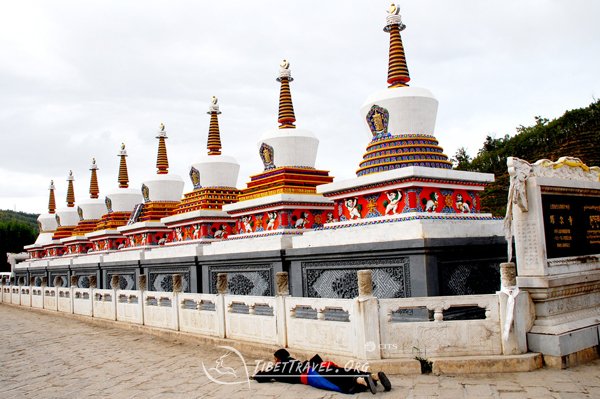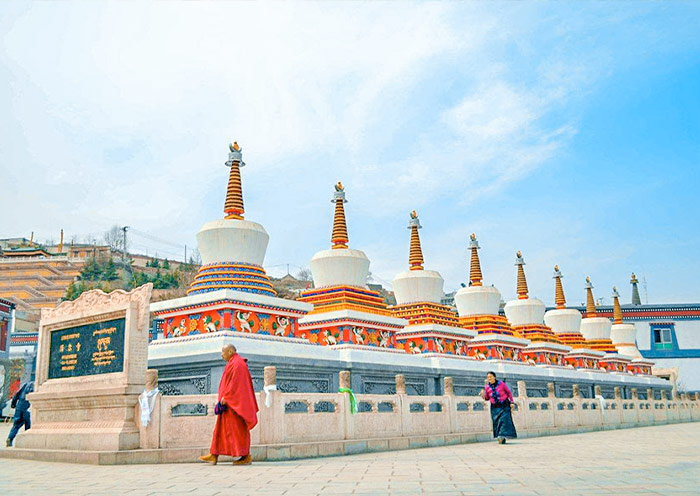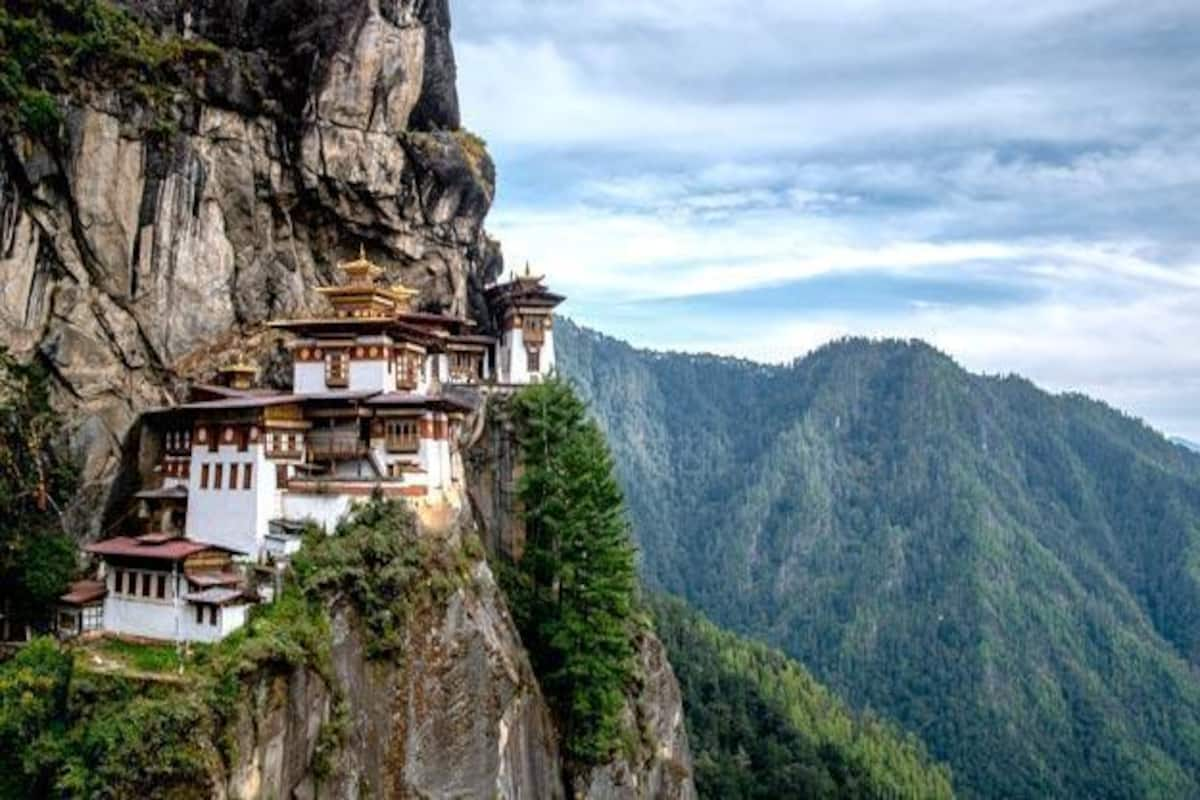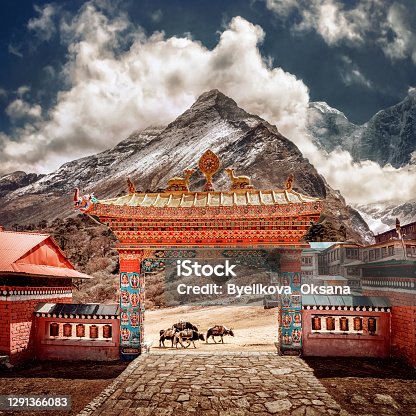Experience Tranquility at Taer Monastery: Top Tips for Your Visit

An Essential Guide to Visiting Taer_Monastery
Nestled in the serene foothills of the mountains, Ta’er Monastery, also known as Kumbum Monastery, stands as a vibrant testament to Tibetan Buddhism’s rich heritage. Located just a short drive from Xining, this architectural marvel is a sanctuary for both spiritual seekers and those curious about the intricate tapestry of Tibetan culture. As you wander through its golden-tiled halls and ancient corridors, the air is filled with the soft chants of monks and the enticing scent of butter sculptures—elements that evoke a sense of peace and reverence.
This historic monastery is not only a place of worship but also a living museum, showcasing exquisite frescoes, delicate embroidery, and the artistic prowess of Tibetan craftsmanship. With its captivating ceremonies, where hundreds of monks gather in prayer, Ta’er Monastery offers visitors a unique glimpse into the spiritual heart of Tibetan Buddhism. Whether you are an avid photographer looking to capture stunning visuals or a traveler eager to immerse yourself in a rich cultural experience, Ta’er Monastery promises a journey that resonates with tranquility and wonder.
As you prepare for your visit, let this guide walk you through the essential details to make the most of your time at this extraordinary destination, ensuring that your experience is both enlightening and unforgettable.
In This Guide
- An Essential Guide to Visiting Taer_Monastery
- The Rich History and Legends of Taer_Monastery
- Main Highlights: What You Absolutely Can’t Miss
- Planning Your Visit: A Practical Guide
- Tickets: Prices, Booking, and Tips
- How to Get There: A Complete Transportation Guide
- Local Cuisine and Accommodation Nearby
- Frequently Asked Questions
- Final Thoughts on Your Trip
The Rich History and Legends of Taer_Monastery
Nestled in the serene landscape of Xining, Ta’er Monastery, also known as Kumbum Monastery, stands as a remarkable testament to Tibetan Buddhism and its rich heritage. Founded in the 16th century, this sacred site is dedicated to the Great Master Tsongkhapa, the revered founder of the Gelug school of Tibetan Buddhism. The monastery’s name, “Kumbum,” translates to “the place of a hundred thousand images,” a fitting tribute to the numerous statues and paintings that adorn its walls.
Ta’er Monastery is notable not just for its spiritual significance but also for its architectural splendor. The complex is an intricate blend of Tibetan and Han Chinese styles, harmoniously integrated into the surrounding mountainous terrain. Visitors are often awestruck by the golden-tiled halls and the Grand Summons Hall, which serve as the heart of the monastery. Here, the air is thick with the scent of butter lamps and the sound of chanting monks, creating an atmosphere that feels both sacred and alive.
Over the centuries, Ta’er Monastery has played a pivotal role in the cultural and spiritual life of Tibetans and Han Chinese alike. It has served as a center for learning, attracting scholars and practitioners from various regions. The monastery’s rich tradition includes the crafting of exquisite butter sculptures and the creation of vibrant frescoes, which are not only artistic expressions but also convey deep religious narratives.
Legends abound concerning Ta’er Monastery, many of which center around its founder, Tsongkhapa. One popular tale recounts how he received divine guidance during a meditation retreat within the monastery’s walls, leading to a profound understanding of Buddhist teachings. This transformative experience laid the groundwork for the Gelug school and solidified Ta’er Monastery’s status as a beacon of Tibetan Buddhism.
Today, visitors to Ta’er Monastery can witness mesmerizing ceremonies where hundreds of monks gather to pray, creating a visual and auditory spectacle that captivates the senses. Despite the influx of tourists, the monastery retains a sense of authenticity and devotion, offering a unique opportunity to engage with Tibetan culture and spirituality.
As you explore the monastery, allow yourself to be drawn into its rich narrative tapestry—one woven from centuries of faith, artistry, and profound philosophical inquiry. Whether you are seeking spiritual solace, cultural enlightenment, or simply a glimpse into the life of this thriving community, Ta’er Monastery promises an unforgettable journey through time and tradition.

Taer_Monastery.
Main Highlights: What You Absolutely Can’t Miss
When visiting Ta’er Monastery, also known as Kumbum Monastery, in Xining, China, you’ll find a wealth of cultural and spiritual experiences awaiting you. Here are the main highlights that you absolutely can’t miss during your visit:
1. Majestic Architecture
The monastery’s stunning architecture is a breathtaking sight, beautifully integrated into the surrounding mountain landscape. The intricate details of the buildings, adorned with golden tiles, frescoes, and vibrant colors, reflect the rich heritage of Tibetan Buddhism. Don’t forget to take your time wandering through the various halls, especially the Greater and Lesser Golden-tiled Halls and the Grand Summons Hall, where you can appreciate the artistry of Tibetan craftsmanship.
2. Mesmerizing Ceremonies
One of the most unforgettable experiences at Ta’er Monastery is witnessing the daily ceremonies. With hundreds of monks engaged in prayer, the atmosphere is both reverent and awe-inspiring. These ceremonies not only provide a glimpse into the spiritual practices of Tibetan Buddhism but also offer a unique opportunity for photography, capturing the essence of a living tradition.
3. Butter Sculptures and Embroidery
As you explore the monastery, be sure to marvel at the exquisite butter sculptures and padded embroidery that adorn many of the halls. These traditional art forms are not only visually stunning but also hold significant cultural meaning. The butter sculptures, often created for festivals, are a testament to the creativity and devotion of the monks.
4. Rich Heritage and History
Ta’er Monastery is not just a place of worship; it is a vital part of Tibetan history and culture. Established in the 16th century, this monastery is the birthplace of Tsongkhapa, the founder of the Gelug school of Tibetan Buddhism. Take the time to learn about its historical significance, which can be enriched by hiring a local guide near the entrance.
5. Scenic Surroundings
The monastery is set against the backdrop of stunning mountains, making the visit not only a spiritual journey but also a scenic one. Take a moment to step outside and enjoy the natural beauty of the area. The serene environment provides a perfect contrast to the often bustling tourist crowds, especially if you visit during off-peak times.
6. Practical Tips for a Great Visit
- Timing Your Visit: To enjoy a more tranquil experience, avoid visiting during Chinese holidays or weekends when crowds can be overwhelming. Aim for a weekday visit if possible.
- Allocate Time: Plan to spend at least three hours exploring the complex to fully appreciate its beauty and cultural depth.
- Ticketing: Consider booking your tickets online to save some money, as this can help you bypass long queues.
- Photography: Don’t miss out on the stunning photography opportunities. Early morning or late afternoon light can enhance your pictures dramatically.
7. Local Cuisine
While there are no restaurants within the monastery grounds, nearby streets offer a variety of local delicacies. After your visit, take a stroll and indulge in some Tibetan or Qinghai cuisine to complete your cultural experience.
With its mesmerizing beauty, rich history, and vibrant spiritual life, Ta’er Monastery promises an unforgettable journey into the heart of Tibetan Buddhism and culture. Be sure to take your time, soak in the atmosphere, and capture the moments that will stay with you long after your visit.

Taer_Monastery.
Planning Your Visit: A Practical Guide
Visiting Ta’er Monastery, also known as Kumbum Monastery, is a captivating journey into the heart of Tibetan Buddhism, rich with history and spiritual significance. To ensure your experience is smooth and rewarding, here’s a practical guide covering everything you need to know before you go.
Getting There
Ta’er Monastery is located approximately 45 minutes by car from Xining, the capital of Qinghai Province. If you’re relying on public transport, consider taking a taxi or arranging a private driver for convenience. The scenic drive offers glimpses of the striking Tibetan Plateau landscapes, making it a pleasant prelude to your visit.
Ticket Information
- Entry Fee: Tickets are priced at 70 RMB. To save some money, it’s advisable to book your tickets online in advance, where you can save around 30 RMB.
- Keep Your Ticket Handy: Admission tickets are checked at various entrances, so make sure to keep yours readily accessible.
Best Time to Visit
- Timing: Aim to visit on a weekday and avoid public holidays to sidestep the crowds and fully immerse yourself in the serene atmosphere.
- Duration: Allocate at least three hours to explore the various halls, courtyards, and the beautiful surroundings of the monastery.
Essential Tips for Your Visit
-
Guided Tours: Hiring a local guide at the entrance can greatly enhance your understanding of the monastery’s history and significance. Look for guides who are knowledgeable about Tibetan Buddhism and the cultural nuances of the area.
-
Photography: The monastery offers incredible photography opportunities, especially during ceremonies. However, always be respectful of the monks and the sacred nature of the space. Remember to ask for permission if you want to photograph individuals.
-
Dress Code: While there isn’t an enforced dress code, it’s best to dress modestly in respect for the religious site. Comfortable footwear is a must, as there will be a fair amount of walking involved.
-
Amenities: There are bathrooms available within the monastery complex. However, dining options are limited, so plan to eat either before you arrive or afterward in the town.
Cultural Considerations
-
Participate Respectfully: If you have the chance to witness a prayer ceremony, be sure to remain quiet and respectful. The sight of hundreds of monks engaged in prayer is awe-inspiring and should be treated with reverence.
-
Local Customs: Be aware of local customs and practices. Avoid touching religious artifacts and always ask before taking photos of people, especially monks.
Nearby Attractions
If you have additional time, consider exploring nearby attractions in Xining, such as the Qinghai Museum or the iconic Dongguan Mosque. Both provide deeper insights into the diverse culture of the region.
Conclusion
Ta’er Monastery is not just a historical site; it’s a living testament to Tibetan culture and spirituality. With its breathtaking architecture, vibrant ceremonies, and serene atmosphere, your visit to this majestic monastery will surely be a memorable highlight of your travels in China. Plan ahead, respect the local customs, and allow yourself the time to absorb the profound beauty of this sacred space. Enjoy your visit!

Taer_Monastery.
Tickets: Prices, Booking, and Tips
Visiting Ta’er Monastery, also known as Kumbum Monastery, is an unforgettable experience that offers a deep dive into Tibetan culture and spirituality. To ensure your visit is smooth and enjoyable, here’s everything you need to know about tickets, prices, and some helpful tips.
Ticket Prices
- Standard Ticket Price: Approximately 70 RMB (around $10)
- Online Booking Discount: If you book your tickets online, you can save about 30 RMB, bringing your total down to approximately 40 RMB (around $6). This is a great way to avoid long lines and ensure you have more time to explore.
Where to Buy Tickets
- Online: The simplest option is to purchase your tickets through official websites or travel apps that operate in China. This not only saves you money but also provides peace of mind on busy days.
- On-site: Tickets can also be purchased at the entrance of the monastery, but be prepared for potential queues, especially during peak tourist periods.
Visiting Tips
-
Plan Your Time: Allocate at least 3 hours to fully explore the monastery complex. This will allow you to appreciate the intricate architecture, stunning frescoes, and the serene atmosphere.
-
Avoid Peak Times: To enjoy a more peaceful experience, plan your visit outside of Chinese public holidays and weekends. These times can see an influx of tourists, making it harder to absorb the spiritual ambiance of the site.
-
Photography Opportunities: Ta’er Monastery is a photographer’s paradise. Take your time to capture the beauty of the golden-tiled halls and the breathtaking mountain backdrop. Early morning or late afternoon light can enhance your photos.
-
Hire a Local Guide: For a richer understanding of the monastery’s history and its significance in Tibetan Buddhism, consider hiring a guide at the entrance. These knowledgeable locals can provide insights that enhance your visit.
-
Keep Your Ticket Handy: Your ticket will be checked at various points throughout the complex, so make sure to keep it accessible.
-
Bathroom and Dining Facilities: There are restroom facilities available within the monastery grounds. However, dining options are located outside, so it’s wise to plan accordingly if you need a meal or snack.
Contact Information
- Phone: +86 971 223 2357
- Address: 居板古巷, 鲁沙尔镇莲花山, Huangzhong District, Xining, Qinghai, China, 811600
Embarking on a journey to Ta’er Monastery is not just a visit to a religious site; it’s an opportunity to immerse yourself in the rich tapestry of Tibetan culture and history. With these tips in hand, you’re well-equipped to make the most of your experience!
How to Get There: A Complete Transportation Guide
To reach the majestic Ta’er Monastery (also known as Kumbum Monastery), nestled in Xining, Qinghai Province, you have several transportation options that cater to different preferences and budgets. Here’s a detailed guide to help you navigate your way to this stunning destination.
Arriving by Air
Nearest Airport:
The closest airport to Ta’er Monastery is Xining Caojiabao Airport (XNN), located approximately 30 kilometers (about 18 miles) from the monastery.
From the Airport to Ta’er Monastery:
1. Taxi: The most convenient way to get to the monastery from the airport is by taxi. Expect to pay around 100-150 RMB and enjoy a scenic 45-minute ride.
2. Airport Shuttle: Check if there are shuttle buses available to Xining city center. From there, you can take a taxi or public transport to reach the monastery.
Arriving by Train
Nearest Train Station:
Xining Railway Station is the main train hub. It is well connected with major cities such as Beijing, Shanghai, and Chengdu.
From the Train Station to Ta’er Monastery:
1. Taxi: A taxi ride from Xining Railway Station to Ta’er Monastery will take about 40 minutes and cost roughly 80-100 RMB.
2. Public Bus: You can take Bus No. 6 or Bus No. 50 to Huangzhong County, where the monastery is located. The bus will drop you off at a short distance from the entrance. This option is cheaper (around 5-10 RMB) but might take longer.
Arriving by Bus
Long-Distance Buses:
If you are coming from nearby cities such as Lanzhou or Chengdu, long-distance buses are available to Xining. Check local schedules for timings and ticket prices.
From Xining to Ta’er Monastery:
1. Bus Services: After arriving in Xining, you can catch a bus from the Xining East Bus Station to Huangzhong County. Buses run regularly, and the fare is typically around 20-30 RMB. The journey takes about an hour.
2. Local Transport: Once in Huangzhong, you can take a taxi or a local minibus to the monastery.
Driving Yourself
If you prefer the freedom of driving, renting a car is an excellent option. The monastery is about a 45-minute drive from Xining, primarily via S101 and G213 highways. Ensure you have a GPS or map app handy, as some road signs may not be in English.
Tips for Your Journey
- Best Time to Visit: To avoid crowds, plan your visit on weekdays and outside of national holidays. Weekends can see a significant influx of tourists.
- Ticket Booking: It is advisable to book your tickets online in advance to save around 30 RMB. General admission is about 70 RMB.
- Time Allocation: Allocate at least three hours to explore the monastery fully, including its magnificent halls and intricate artworks.
- Dining Options: While there are no restaurants within the monastery, you can find dining options in the nearby streets after your visit.
With these transportation options at your fingertips, your journey to Ta’er Monastery will be as enriching as the experience itself. Enjoy your exploration of this significant cultural and spiritual site!

Taer_Monastery.
Local Cuisine and Accommodation Nearby
Nestled in the serene beauty of the Qinghai Plateau, Ta’er Monastery is not only a feast for the eyes but also an opportunity to indulge in local flavors and find comfortable accommodations nearby. After exploring the rich tapestry of Tibetan culture within the monastery’s walls, treat yourself to some delightful local cuisine and rest your head in cozy lodgings that reflect the spirit of this unique region.
Culinary Delights
1. Local Tibetan Restaurants:
– Tibetan Family Kitchen: Just a short drive from the monastery, this family-run restaurant offers authentic Tibetan dishes like momos (dumplings), thukpa (noodle soup), and buttery yak meat. The warm, inviting atmosphere makes it an excellent spot to unwind after your visit.
– Tibet Flavor: Located in nearby Xining, this eatery serves an array of traditional Tibetan meals and is known for its flavorful yak butter tea. Be sure to try their fried bread, a local favorite that pairs perfectly with the rich, savory dishes.
2. Street Food Stalls:
– If you’re feeling adventurous, head to the main street area outside the monastery where various food stalls offer quick bites. Sample local snacks like zha jiao (fried dough balls) and sweet barley tea as you soak in the vibrant atmosphere.
Comfortable Stays
1. Xining Hotels:
– Qinghai Hotel: A comfortable choice located about 30 minutes from Ta’er Monastery, this hotel offers modern amenities and stunning views of the surrounding mountains. Their on-site restaurant serves a mix of local and international cuisine, making it convenient for travelers seeking variety.
– Tibetan Culture Hotel: This hotel is perfect for those wanting to immerse themselves in Tibetan culture. The decor reflects traditional styles, and the staff is knowledgeable about the area, providing insights into local customs and attractions.
2. Guesthouses:
– Lanzhou Road Guesthouse: A cozy and affordable option, this guesthouse is just a stone’s throw from the main attractions in Xining. With friendly hosts and a homey atmosphere, it’s an ideal place to relax after a day of exploration.
– Tashi Guesthouse: Located near the monastery, Tashi Guesthouse offers a unique experience with its Tibetan-style architecture. Guests rave about the hospitality and the opportunity to participate in local cultural activities.
Tips for Your Visit
- Make sure to indulge in the local beverages, especially the famous Tibetan butter tea, which is a unique experience that complements the region’s flavors.
- For a more authentic experience, opt for accommodations that offer local Tibetan breakfast options, setting the perfect tone for your day of exploration.
With an array of delectable dishes and welcoming places to stay, your visit to Ta’er Monastery will be enriched by the flavors and warmth of Tibetan hospitality. Enjoy every moment as you dive deeper into the culture and landscape of this remarkable region.

Taer_Monastery.
Frequently Asked Questions
-
What is Ta’er Monastery, and why should I visit?
Ta’er Monastery, also known as Kumbum Monastery, is a stunning Tibetan temple located near Xining, China. It’s renowned for its breathtaking architecture, vibrant ceremonies featuring hundreds of monks, and rich cultural heritage. Visiting offers a unique glimpse into Tibetan Buddhism and an opportunity for stunning photography. -
How do I get to Ta’er Monastery from Xining?
The monastery is approximately a 45-minute drive from Xining. You can hire a taxi, join a guided tour, or use local public transportation to reach this remarkable site. -
What are the opening hours and ticket prices?
While specific opening hours can vary, it is generally open daily. As of 2019, regular admission tickets cost 70 RMB, but purchasing tickets online can save you about 30 RMB. Always check for the latest pricing and hours before your visit. -
How much time should I allocate for my visit?
It’s recommended to set aside at least 3 hours to explore the monastery thoroughly. This will give you ample time to appreciate the intricate architecture, view the various halls, and possibly witness a prayer ceremony. -
Are there any facilities available at the monastery?
Yes, Ta’er Monastery has bathroom facilities available for visitors. However, dining options are limited within the monastery complex, so you may want to plan to eat at restaurants located nearby in the main street area. -
Can I take photographs inside the monastery?
Visitors are generally allowed to take photographs in many areas of the monastery, but be respectful of sacred spaces and ceremonies. Always be mindful of the presence of monks and other worshippers, and refrain from using flash photography during prayer sessions. -
Is it advisable to hire a guide during my visit?
Hiring a guide at the entrance can greatly enhance your experience by providing deeper insights into the complex’s history and significance. Guides are typically available for a reasonable fee and can help you navigate the various halls and their cultural meanings. -
When is the best time to visit Ta’er Monastery?
To avoid large crowds, it’s best to visit during weekdays and avoid public holidays. Early mornings are particularly serene, allowing for a more peaceful experience as you explore the monastery’s beautiful grounds.
Final Thoughts on Your Trip
As you conclude your journey through the mesmerizing Ta’er Monastery, also known as Kumbum Monastery, you’ll carry home not just memories but a deep appreciation for Tibetan culture and spirituality. This vibrant temple, nestled against the backdrop of majestic mountains, offers a unique blend of breathtaking architecture and a living tradition that echoes through the prayers of the monks and the intricate artistry that adorns its halls.
Whether you were captivated by the stunning butter sculptures, the ethereal frescoes, or the serene atmosphere of prayer ceremonies, Ta’er Monastery is sure to leave an indelible mark on your heart. Remember to allow yourself ample time to explore its many facets, as each corner reveals a new story woven into the rich tapestry of Tibetan Buddhism.
For future travelers, consider visiting during off-peak times to fully embrace the monastery’s tranquility, and don’t hesitate to engage with local guides who can illuminate the history and significance of this sacred site. With every visit to Ta’er Monastery, you not only witness a piece of cultural heritage but also partake in a living narrative that continues to inspire and resonate.
As you depart, let the serene chants of the monks linger in your mind, a reminder of the spiritual journey you embarked upon. Until your next adventure, may the lessons of peace, reflection, and cultural appreciation continue to guide you on your travels.